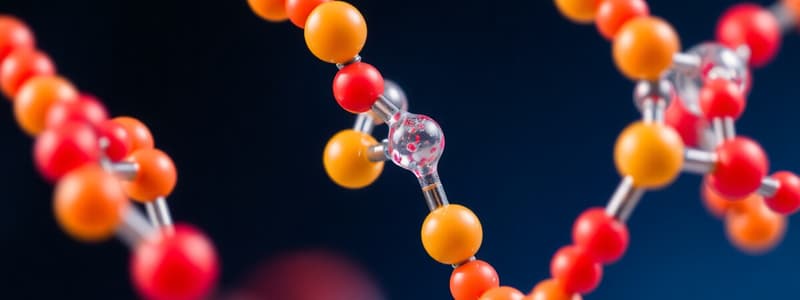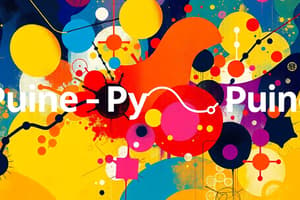Podcast
Questions and Answers
Which of the following correctly defines a nucleoside?
Which of the following correctly defines a nucleoside?
- A nucleoside is a nucleotide without a nitrogenous base.
- A nucleoside is only a sugar molecule.
- A nucleoside is a sugar with multiple phosphate groups.
- A nucleoside contains a nitrogenous base covalently attached to a sugar. (correct)
What is true about adenosine-5’-monophosphate (AMP)?
What is true about adenosine-5’-monophosphate (AMP)?
- AMP is a nucleoside without a nitrogenous base.
- AMP is a purine base synthesized from nucleotides.
- AMP is a nucleotide that includes a nitrogenous base and one phosphate group. (correct)
- AMP contains two phosphate groups.
Which molecule is the starting material for the synthesis of PRPP in purine nucleotide synthesis?
Which molecule is the starting material for the synthesis of PRPP in purine nucleotide synthesis?
- Glutamine
- Adenosine
- Ribose-5-phosphate (correct)
- IMP
In the de novo synthesis of purine nucleotides, which sources provide atoms necessary for purine base formation?
In the de novo synthesis of purine nucleotides, which sources provide atoms necessary for purine base formation?
What is the first purine nucleotide formed in de novo synthesis?
What is the first purine nucleotide formed in de novo synthesis?
Which component is NOT part of the initial steps in purine nucleotide synthesis?
Which component is NOT part of the initial steps in purine nucleotide synthesis?
Which of the following is part of the structure of a nucleotide?
Which of the following is part of the structure of a nucleotide?
When synthesize the purine ring structure, which position of sugar is initially modified?
When synthesize the purine ring structure, which position of sugar is initially modified?
Which substance is considered a product of the pentose phosphate pathway that is used in nucleotide synthesis?
Which substance is considered a product of the pentose phosphate pathway that is used in nucleotide synthesis?
What type of base is adenine classified as?
What type of base is adenine classified as?
What is the initial substrate used in the de novo synthesis of pyrimidine nucleotides?
What is the initial substrate used in the de novo synthesis of pyrimidine nucleotides?
Which enzyme is responsible for the formation of carbamoyl phosphate from bicarbonate, ATP, and glutamine?
Which enzyme is responsible for the formation of carbamoyl phosphate from bicarbonate, ATP, and glutamine?
What compound is formed after the cyclization and modification of carbamoyl phosphate and aspartate?
What compound is formed after the cyclization and modification of carbamoyl phosphate and aspartate?
How is orotate converted into OMP?
How is orotate converted into OMP?
What is the consequence of mutations in the HGPRT enzyme?
What is the consequence of mutations in the HGPRT enzyme?
What advantage does the salvage pathway provide in nucleotide synthesis?
What advantage does the salvage pathway provide in nucleotide synthesis?
Which of the following is a product of the modification of OMP?
Which of the following is a product of the modification of OMP?
Which substance does the salvage pathway recycle primarily?
Which substance does the salvage pathway recycle primarily?
What is the final product of the de novo pyrimidine synthesis pathway?
What is the final product of the de novo pyrimidine synthesis pathway?
Which of the following is a key difference between purine and pyrimidine nucleotide synthesis?
Which of the following is a key difference between purine and pyrimidine nucleotide synthesis?
Flashcards
Nucleoside
Nucleoside
A nucleoside is a nitrogenous base covalently attached to a sugar.
Nucleotide
Nucleotide
A nucleotide is a nucleoside with one or more phosphate groups attached to the sugar.
Purine
Purine
A type of nitrogenous base found in nucleotides such as adenine.
De novo purine nucleotide synthesis
De novo purine nucleotide synthesis
The process of creating purine nucleotides from simpler molecules.
Signup and view all the flashcards
Ribose-5-phosphate
Ribose-5-phosphate
A sugar used in the synthesis of purine nucleotides.
Signup and view all the flashcards
PRPP
PRPP
A molecule used in both de novo and salvage purine synthesis pathways.
Signup and view all the flashcards
IMP
IMP
The first purine nucleotide synthesized by the de novo pathway.
Signup and view all the flashcards
Adenine
Adenine
A purine base involved in forming nucleotides and nucleosides.
Signup and view all the flashcards
De novo synthesis
De novo synthesis
Creating molecules from simpler components.
Signup and view all the flashcards
Salvage pathway
Salvage pathway
Reusing pre-formed purine bases to make nucleotides.
Signup and view all the flashcards
Pyrimidine synthesis substrate
Pyrimidine synthesis substrate
PRPP is the sugar substrate for pyrimidine nucleotide synthesis, similar to purine synthesis.
Signup and view all the flashcards
Pyrimidine ring synthesis order
Pyrimidine ring synthesis order
In pyrimidine synthesis, the ring structure is made first, then attached to PRPP.
Signup and view all the flashcards
Carbamoyl phosphate synthetase II role
Carbamoyl phosphate synthetase II role
This enzyme forms carbamoyl phosphate from HCO3-, ATP, and glutamine.
Signup and view all the flashcards
Orotate formation
Orotate formation
Carbamoyl phosphate and aspartate join, form a ring (cyclize), and change to create orotate.
Signup and view all the flashcards
Orotate's role in nucleotide synthesis
Orotate's role in nucleotide synthesis
Orotate gets linked to PRPP to form OMP, processed further to make UMP and CMP.
Signup and view all the flashcards
Purine salvage pathway
Purine salvage pathway
Recycles pre-existing purines, instead of creating them from scratch.
Signup and view all the flashcards
HGPRT enzyme function
HGPRT enzyme function
Links guanine to PRPP to make a nucleotide (GMP).
Signup and view all the flashcards
Lesch-Nyhan Syndrome cause
Lesch-Nyhan Syndrome cause
Mutations in the HGPRT gene cause this genetic disorder.
Signup and view all the flashcards
De novo synthesis cost
De novo synthesis cost
Creating nucleotides from scratch is energetically expensive.
Signup and view all the flashcards
Salvage pathway use
Salvage pathway use
Salvage pathway avoids more costly de novo synthetic steps for nucleotides.
Signup and view all the flashcardsStudy Notes
Bases, Nucleosides, and Nucleotides
- Adenine is a purine nitrogenous base.
- A nucleoside combines a nitrogenous base (like adenine) with a sugar (like ribose). Adenosine is an example.
- A nucleotide is a nucleoside with one or more phosphate groups attached to the sugar. Adenosine-5'-monophosphate (AMP) is an example.
De Novo Synthesis of Purine Nucleotides
- Ribose-5-phosphate, from the pentose phosphate pathway, is converted to PRPP (5-phospho-alpha-D-ribosyl-1-pyrophosphate).
- PRPP is the sugar substrate for purine synthesis.
- The purine base is synthesized on the C1 position of the sugar, using atoms from glutamine, THF, glycine, aspartate, and CO2.
- IMP is the first purine nucleotide formed.
- IMP is modified to form further nucleotides like AMP and GMP.
Pyrimidine Synthesis (De Novo Pathway)
- PRPP is the sugar substrate for pyrimidine synthesis.
- The pyrimidine ring is synthesized first and then attached to PRPP.
- Carbamoyl phosphate synthetase II catalyzes the formation of carbamoyl phosphate from HCO3-, ATP, and glutamine.
- Carbamoyl phosphate and aspartate are covalently linked, cyclized, and modified to generate orotate.
- Orotate is linked to PRPP to form OMP. OMP is modified to form UMP and CMP.
Salvage Pathway for Purine Nucleotides
- De novo synthesis of nucleotides is energetically costly.
- The salvage pathway recycles existing purines (like guanine) to avoid needing to synthesize everything from scratch.
- Degradation of nucleotides can release nitrogenous bases.
- PRPP is used in the salvage pathway.
- Hypoxanthine-guanine phosphoribosyltransferase (HGPRT) catalyzes the covalent linkage of guanine to PRPP to form guanosine-5'-monophosphate (GMP).
- Mutations in HGPRT cause Lesch-Nyhan Syndrome.
Studying That Suits You
Use AI to generate personalized quizzes and flashcards to suit your learning preferences.




